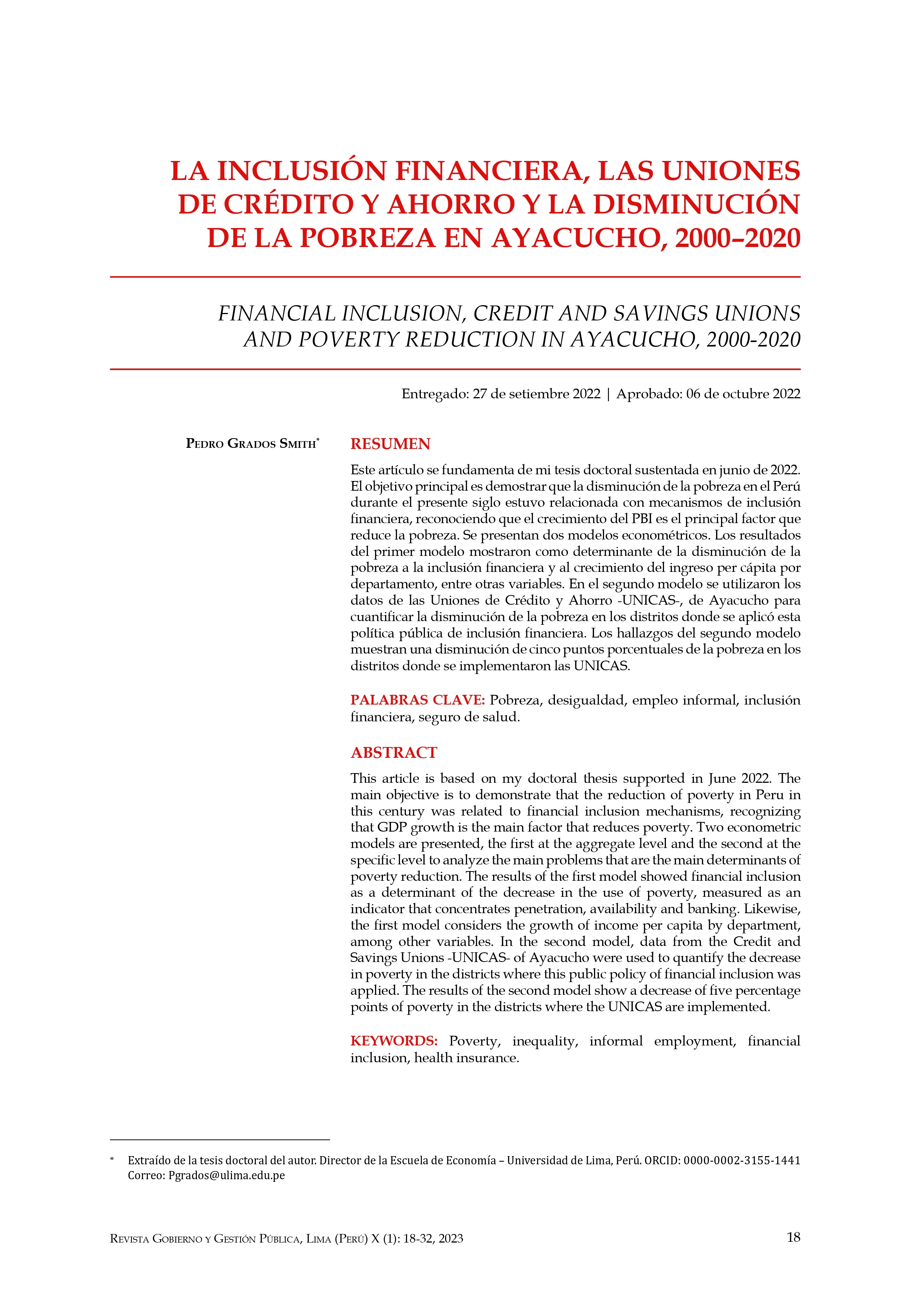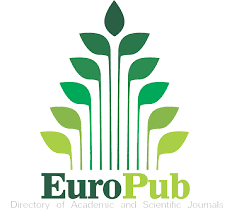LA INCLUSIÓN FINANCIERA, LAS UNIONES DE CRÉDITO Y AHORRO Y LA DISMINUCIÓN DE LA POBREZA EN AYACUCHO, 2000–2020
DOI:
https://doi.org/10.24265/iggp.2023.v10n1.03Palabras clave:
Pobreza, Desigualdad, Empleo informalResumen
Este artículo se fundamenta de mi tesis doctoral sustentada en junio de 2022. El objetivo principal es demostrar que la disminución de la pobreza en el Perú durante el presente siglo estuvo relacionada con mecanismos de inclusión financiera, reconociendo que el crecimiento del PBI es el principal factor que
reduce la pobreza. Se presentan dos modelos econométricos. Los resultados del primer modelo mostraron como determinante de la disminución de la pobreza a la inclusión financiera y al crecimiento del ingreso per cápita por departamento, entre otras variables. En el segundo modelo se utilizaron los datos de las Uniones de Crédito y Ahorro -UNICAS-, de Ayacucho para cuantificar la disminución de la pobreza en los distritos donde se aplicó esta política pública de inclusión financiera. Los hallazgos del segundo modelo muestran una disminución de cinco puntos porcentuales de la pobreza en los distritos donde se implementaron las UNICAS.
Descargas
Referencias
Allen, H. y Staehle, M. (2007). Programme guide — Field operations manual Version 3.1. Stuttgart, Germany: VSL Associates Ltd. https://www.rfilc.org/wp content/uploads/2020/08/1254222281821_VSL_Programme_Guide_3.1_English.pdf
Ahlin, C. and Townsend, R. (2007). Using repayment data to test across models of joint liabilitylending. The Economic Journal, 117(517), 11–51. https://doi.org/10.1111/j.1468-0297.2007.02014.x
Amidžić, G., Massara, A. y Mialou, A. (2014). Assessing countries’ financial inclusion standing A new composite index. International Monetary Fund, WP 14/36. https://www.imf.org/external/pubs/ft/wp/2014/wp1436.pdf
Angrist, J. y Pischke, J. (2009). Mostly harmless econometrics: An empiricist’s companion. Princeton,USA: Princeton University Press.
APOYO (2006). El gasto social en el Perú 2000-2005. Lima, Perú: APOYO. Armendariz de Aghion, B. y Gollier, C. (2000). Peer group formation in an adverse selection model. The Economic Journal, 110(465), 632–643. https://doi.org/10.1111/1468-0297.00557
Attanasio, O., Augsburg, B., De Haas, R., Fitzsimons, E. y Harmgart, H. (2011). Group lending or individual lending? Evidence from a randomized field experiment in Mongolia. Institute for Fiscal Studies, WP11/20. https://www.econstor.eu/handle/10419/91536
Augsburg, B., De Haas, R., Harmgart, H. y Meghir, C. (2012). Microfinance at the margin: experimental evidence from Bosnia and Herzegovina. European Bank for Reconstruction and Development, WP146. https://hdl.handle.net/10419/93061
Azariadis, C. y Stachurski, J. (2005). Poverty trap. In Aghion, P. and Durlauf, S., Handbook of Economic Growth, Chapter 5, 1(1). Amsterdam, Netherlands: Elsevier New-Holland.https://doi.org/10.1016/S1574-(05)01107-X
Balboni, C., Bandiera, O., Burgess, R., Ghatak, M. y Heil, A. (2020). Why do people stay poor? STICERD-Suntory and Toyota International Centres for Economics and Related Disciplines, Economic Organisation and Public Policy, Discussion Papers Series 067. London, UK: London School of Economics.https://personal.lse.ac.uk/ghatak/PovertyTraps.pdf
Banco Mundial (2019). Data Bank. https://databank.worldbank.org/source/world-development-indicators
Banerjee, A. and Newman, A. (1993). Occupational choice and the process of development. The American Economic Review, 84(2), 211-215. https://doi.org/10.1086/261876
Banerjee, A., Besley, T. and Guinnane, T. (1994). Thy neighbor’s keeper: the design of a credit cooperative with theory and a test. Quarterly Journal of Economics, 109(2), 491–515. https://doi.org/10.2307/2118471
Banerjee, A. y Newman, A. (1994). Poverty, incentives, and development. The American Economic Review, (2), 211-215. http://www.jstor.org/stable/2117831
Banerjee, A., Benabou, R. y Mookherjee, D. (2006). Understanding Poverty. Oxford, UK: OxfordUniversity Press.
Banerjee, A. y Mullainathan, S. (2007). Climbing out of poverty: long term decisions under income stress. Mimeo, London, UK: BREAD conference at CEPR.
Banerjee, A. y Mullainathan, S. (2010). The shape of temptation: implications for the economic lives of the poor. Mimeo, Cambridge, USA: Massachusetts Institute of Technology.
Banerjee, A. y Duflo, E. (2011). Repensar la pobreza. Un giro radical en la lucha contra la desigualdadglobal. Bogotá, Colombia: Taurus.
Banerjee, A., Karlan, D. y Zinman, J. (2015). Six randomized evaluations of microcredit: introduction and further steps. American Economic Journal: Applied Economics, 7(1), 1–21. DOI: 10.1257/app.20140287
Banerjee, A., Duflo, E., Glennerster, R. y Kinnan, C. (2015). The miracle of microfinance? Evidence from a randomized evaluation. American Economic Journal: Applied Economics, 7(1), 22–53. DOI: 10.1257/app.20140287
Banerjee, A., Breza, E., Duflo, E. y Kinnan, C. (2019). Can microfinance unlock a poverty trap some entrepreneurs? National Bureau of Economic Research, WP 26346. DOI 10.3386/w26346
COFIDE (2017). Programa inclusivo de desarrollo empresarial rural.https://www.cepal.org/sites/default/files/events/files/2a_04_pedro_grados_cofide.pdf
COFIDE (2020). Datos PRIDER de Inclusión Financiera en Ayacucho.
CEPAL (1991). Magnitud de la pobreza en América Latina en los años ochenta. Estudios e informes, 81.
CEPAL (2018). Panorama social de América Latina. Santiago de Chile, Chile: CEPAL.https://repositorio.cepal.org/bitstream/handle/11362/44395/11/S1900051_es.pdf
Frisancho, V. y Valdivia, M. (2020). Savings groups reduce vulnerability but have mixed effects on financial inclusion. Inter-American Development Bank, WP 1166. https://www.econstor.eu/bitstream/10419/237461/1/IDB-WP-1166.pdf
Gerschenkron, A. (1962). Economic backwardness in historical perspective. Cambridge, USA: The Belknap Press.
INEI (2011). Perú: perfil de la pobreza por departamentos, 2001-2010. Lima, Perú: INEI. https://www.inei.gob.pe/media/MenuRecursivo/publicaciones_digitales/Est/Lib0981/Libro.pdf
INEI (2018). Producción y empleo informal en el Perú: cuenta satélite de la economía informal 2007-2017. Lima, Perú: INEI. https://www.inei.gob.pe/media/MenuRecursivo/publicaciones_digitales/Est/Lib1589/libro.pdf
INEI (2019). Evolución de la pobreza monetaria 2007-2018. Lima, Perú: INEI. https://www.inei.gob.pe/media/MenuRecursivo/publicaciones_digitales/Est/Lib1533/libro.pdf
INEI (2020). Gastos en programas sociales. Lima, Perú: INEI. Recuperado de https://www.inei.gob.pe/estadisticas/indice-tematico/spending-on-social-programs/
Instituto Peruano de Economía (2020). ¿Cuál es la diferencia entre los cálculos de pobreza monetaria y pobreza multidimensional? Lima: IPE. https://www.ipe.org.pe/portal/cual-es-la-diferencia-entre-los-calculos-depobreza-monetaria-y-pobreza-multidimensional/
Jalan, J. y Ravallion, M. (2002). Geographic poverty traps? A micro model of consumption growth in rural China. Journal of Applied Econometrics, 17(4), 329–46. https://doi.org/10.1002/jae.645
Kraay, A. (2004). When is growth pro-poor? Cross-country evidence. International Monetary FundWP 04/47. https://papers.ssrn.com/sol3/papers.cfm?abstract_id=878870
Kraay, A. (2006). When is growth pro-poor? Evidence from a panel of countries. Journal of Development Economics, 80(1), 198-227. https://doi.org/10.1016/j.jdeveco.2005.02.004
Kraay, A. y Raddatz, C. (2007). Poverty traps, aid, and growth. Journal of Development Economics, 82(2), –47. https://doi.org/10.1016/j.jdeveco.2006.04.002
Kraay, A., and McKenzie, D. (2014). Do poverty traps exist? Assessing the evidence. Journal of Economic Perspectives, 28(3), 127–148. DOI: 10.1257/jep.28.3.127
Kuznets, S. (1955). Economic growth and income inequality. American Economic Review 45(1), l-28.
Kuznets, S. (1959). Quantitative aspects of the economic growth of nations: VIII. Distribution of income by size. Economic Development and Cultural Change, 11(2), 1-100.
Loayza, N.V., Serven, L. y Sugawara, N. (2009). Informality in Latin America and the Caribbean. WorldBank, WP 4888. https://doi.org/10.1596/1813-9450-4888
Loayza, N. (2020). Costs and trade-offs in the fight against the COVID-19 pandemic: a developing country perspective. World Bank, Research & Policy Briefs 35. http://hdl.handle.net/10986/33764
Mahdi, A. (2010). Poverty and informality: a restraining or constructive relationship? Economic Research Forum. WP 569.
Mahler, D., Lakner C., Castanedam R., & Haoyu, W. (2020). Updated estimates of the impact of COVID-19 on global poverty. World Bank Blogs. https://blogs.worldbank.org/opendata/updated-estimates-impactcovid-19-global-poverty
Maurizio, R. (2012). Labour informality in Latin America: the case of Argentina, Chile, Brazil, and Peru. Brooks World Poverty Institute, Working Paper 165.
Mazumdar, D. (1959). The marginal productivity theory of wages and disguised unemployment. The Review of Economic Studies, 26(3), 190–97. https://doi.org/10.2307/2295747
McKnight, A. (2018). How are inequality and poverty linked? Centre for Analysis of Social Exclusion.London, UK: London School of Economics.
Meschi, E. y Vivarelli, M. (2009). Trade and income inequality in developing countries. WorldDevelopment, (2), 287–302. https://doi.org/10.1016/j.worlddev.2008.06.002
Muhammad, Y. (1998). Hacia un mundo sin pobreza. Madrid, España: Planeta
Muhammad, Y. (2006). El banquero de los pobres: los microcréditos y la batalla contra la pobreza enel mundo. Madrid, España: Planeta.
Murray, C. (1990). The emerging British underclass. London, UK: Health and Welfare Unit.
ONU (2017). Poner fin a la pobreza en todas sus formas en todo el mundo. https://www.un.org/sustainabledevelopment/es/poverty/
ONU (2020). Estimates of the impact of COVID-19 on global poverty. WIDER, WP 2020/43. https://www.wider.unu.edu/sites/default/files/Publications/Working-paper/PDF/wp2020-43.pdf
Sachs, J. (2005). The End of Poverty. London, UK: Penguin.
Sadoulet, L. y Carpenter, S. (1999). Risk-matching in credit groups: evidence from Guatemala, Econometric Society World Congress 2000 Contributed Papers 1310, Econometric Society. http://fmwww.bc.edu/RePEc/es2000/1310.pdf
Sarma, M. (2008). Index of financial inclusion. Indian Council for Research on International Economic
Relations. WP 215. http://icrier.org/pdf/Working_Paper_215.pdf
Stiglitz, J. (1990). Peer monitoring and credit markets. The World Bank Economic Review, 4(3), 351-366. https://doi.org/10.1093/wber/4.3.351 2006-2011-Nº 3, 2006. Lima: Consorcio de Investigación Económica y Social (CIES).
Valdivia, M. (2013). Acerca de la dinámica de los grupos de ahorro y crédito de COFIDE. Lima, Perú: GRADE.
Villa, J. (2016). Diff: Simplifying the estimation of difference-in-differences treatment effects. TheStata Journal, (1), 52-71. https://doi.org/10.1177/1536867X1601600108
Webb, R. (2017). Evaluación cualitativa de los resultados obtenidos por el Programa Inclusivo de Desarrollo Empresarial Rural – PRIDER en el departamento de Cajamarca. Lima, Perú: COFIDE.
White, H., Sabarwal, S. y Hoop, T. (2014). Ensayos controlados aleatorios. Centro de Investigaciones Innocenti. Florencia, Italia: UNICEF.
Wooldridge, J. M. (2016). Introductory econometrics: a modern approach. 6th ed., Boston, USA: Cengage Learning.
World Bank (2004). Micro and rural finance in Ghana: evolving industry and approaches to regulation findings. Washington D.C, USA: The World Bank.
World Bank (2004a). Global poverty down by half since 1981 but progress uneven as economic grow the ludes many countries. News Release 2004/309/S.
World Bank (2004b). World Development Indicators. New York, USA: Oxford University Press.
World Bank (2019). Global findex. Washington D. C., USA: World Bank. https://www.bancomundial.org/es/news/press-release/2018/04/19/financial-inclusion-on-the-rise-but-gaps-remain-global-findexdatabase-shows

Descargas
Publicado
Número
Sección
Licencia
Derechos de autor 2022 Pedro Grados Smith

Esta obra está bajo una licencia internacional Creative Commons Atribución-NoComercial-CompartirIgual 4.0.











